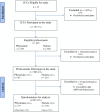Burnout in intensive care units - a consideration of the possible prevalence and frequency of new risk factors: a descriptive correlational multicentre study
- PMID: 24172172
- PMCID: PMC3826848
- DOI: 10.1186/1471-2253-13-38
Burnout in intensive care units - a consideration of the possible prevalence and frequency of new risk factors: a descriptive correlational multicentre study
Abstract
Background: The provision of Intensive Care (IC) can lead to a health care provider's physical, psychological and emotional exhaustion, which may develop into burnout. We notice the absence of specific studies regarding this syndrome in Portuguese Intensive Care Units (ICUs). Our main objective is to study the incidence and risk factors of burnout in Portuguese ICUs.
Methods: A self-fulfilment questionnaire containing 3 items: (i) socio-demographic data of the study population; (ii) experiences in the workplace; (iii) Maslach Burnout Inventory (MBI) - was applied to evaluate the influence of distinct factors on the prevalence of burnout among physicians and nurses working in ICUs.
Results: Three hundred professionals (82 physicians and 218 nurses) from ten ICUs were included in the study, out of a total of 445 who were eligible. There was a high rate of burnout among professionals working in Portuguese ICUs, with 31% having a high level of burnout. However, when burnout levels among nurses and physicians were compared, no significant difference was found. Using multivariate analysis, we identified gender as being a risk factor, where female status increases the risk of burnout. In addition, higher levels of burnout were associated with conflicts and ethical decision making regarding withdrawing treatments. Having a temporary work contract was also identified as a risk factor. Conversely, working for another service of the same health care institution acts as a protective factor.
Conclusions: A high rate of burnout was identified among professionals working in Portuguese ICUs. This study highlights some new risk factors for burnout (ethical decision making, temporary work contracts), and also protective ones (maintaining activity in other settings outside the ICU) that were not previously reported. Preventive and interventive programmes to avoid and reduce burnout syndrome are of paramount importance in the future organization of ICUs and should take the above results into account.
Figures
References
-
- Delbrouck M. Síndrome de Exaustão (Burnout) Lisboa: Climepsi Editores; 2006.
-
- Maslach C, Leiter MP. The truth about Burnout. How Organizations cause personal stress and what to do about it. San Francisco, CA: Jossey-Bass; 1997.
LinkOut - more resources
Full Text Sources
Other Literature Sources
Molecular Biology Databases


